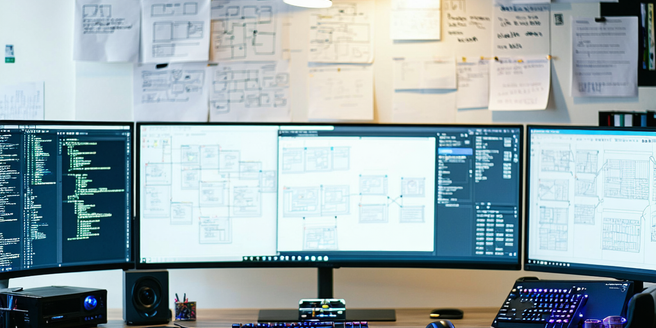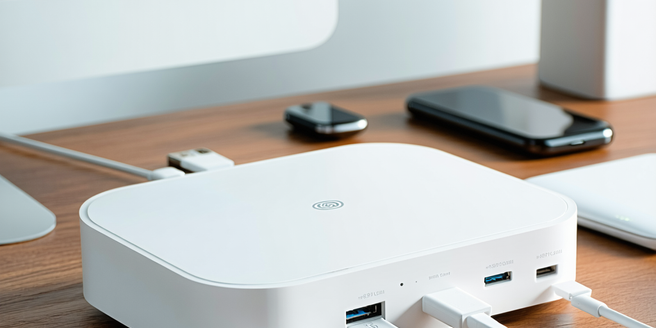
The Ultimate Guide To Home Networking
Understanding the basics of home networking involves familiarizing oneself with key components like routers, modems, and bandwidth. A modem connects to the internet, while a router links multiple devices, allowing data communication within a home. Acquiring knowledge of hardware needs, such as dual-band routers, network switches, and Wi-Fi extenders, is crucial for a robust network setup. Ensuring network security is essential, with steps like changing default SSID, enabling WPA3 encryption, and setting strong passwords. Optimizing network performance involves strategic router placement, utilizing 5 GHz frequencies, and prioritizing bandwidth. Regular maintenance and monitoring help in addressing common issues, such as reconnecting devices, updating firmware, and checking for ISP outages. Overall, understanding these elements can enhance connectivity, speed, and security within a home network.

Mobile Apps For Task Organization
Task organization apps are crucial in today’s fast-paced environment, providing a structured platform for managing to-do lists, deadlines, and priorities. These apps enhance productivity by reducing mental clutter, offering reminders, categorization, and progress tracking to ensure efficient time allocation. When selecting a task app, prioritize features like an intuitive interface, collaboration tools, device synchronization, and integration capabilities. Popular apps like Todoist, Trello, and Asana cater to different organizational styles, making it essential to match app features with personal and professional needs. Maximize productivity by setting clear goals, adjusting task priorities, and utilizing synchronization and integration features. Testing various apps can help find the best fit for achieving personal and professional organizational goals.

Drones In Daily Life
Drone technology has significantly evolved, transitioning from basic military tools to sophisticated devices used in various fields. Modern drones now feature high-resolution cameras, autonomous flight capabilities, and advanced sensors, expanding their applications into photography, logistics, agriculture, emergency response, urban planning, and more. In agriculture, drones boost productivity by offering detailed aerial views for precision farming, helping with crop health monitoring and resource management. In urban development, drones provide crucial aerial data for efficient city planning and real-time construction monitoring. Emergency services benefit from drones' real-time data and imaging capabilities for search, rescue, and disaster response. Looking ahead, the integration of AI and new materials promises even more efficient, autonomous drones, advancing their usability in diverse sectors such as delivery, transport, and environmental monitoring. The drone industry continues to innovate, balancing technological advances with evolving regulations, setting the stage for future expansion.

Innovative Fitness Trackers And Wellness
Fitness trackers have evolved from basic pedometers to advanced wellness devices that track heart rate, sleep patterns, and stress levels. Key features now include GPS, hydration tracking, and virtual coaching. These devices enhance health by providing real-time feedback, encouraging active lifestyles, and supporting mental well-being. Leading brands like Fitbit, Garmin, and Apple are key innovators, offering user-friendly and feature-rich products. Technology's role in personal wellness is crucial, with AI and machine learning providing personalized health insights. The future holds even more innovative solutions for fitness and wellness gadgets.

Securing Collaboration Tools From Home
Remote collaboration is essential in today’s interconnected world, but it presents security risks that need addressing. Unprotected networks and personal devices can expose sensitive data, necessitating secure connections and adherence to corporate security measures. Collaboration tools can be vulnerable if not secured properly, serving as potential entry points for cybercriminals. To mitigate these risks, organizations must develop effective security strategies, invest in secure technologies, and enforce strict security policies. Training employees on best practices further enhances security. Implementing strong authentication measures, like multi-factor authentication and biometrics, is crucial to protect collaboration tools. Regular password updates and educating employees on safe password practices help prevent unauthorized access. Data encryption is vital for online communication, making intercepted information unreadable. End-to-end encryption should be used in collaboration tools and stored data to protect against threats. Secure file sharing is also key; using encrypted platforms with access controls is essential for protecting sensitive data. By adopting these enhanced security measures, organizations can ensure efficient and safe remote collaboration.

E-waste Solutions: Responsible Mobile Disposal
E-waste, or electronic waste, poses a significant environmental challenge due to the hazardous substances in discarded electronic devices that can contaminate soil and water. High turnover rates of devices, especially mobile phones, contribute heavily to the e-waste crisis, as they often contain harmful materials and are improperly disposed. Effective strategies for recycling involve improving collection systems, raising consumer awareness, and utilizing certified recyclers. Innovations in e-waste management, such as AI-based sorting systems and environmentally friendly extraction methods, are essential for improving recycling efficiency. Consumer responsibility and awareness are vital in sustainable mobile disposal, with education and incentives playing a key role. Policymaking is also critical for enforcing sustainable practices, ensuring proper handling and promoting manufacturer responsibility.

Code Collaboration Through Github
Enhance your software development workflow by mastering Git and GitHub. Git is a distributed version control system essential for tracking changes in a codebase, while GitHub hosts these repositories and adds a collaborative layer, allowing seamless sharing and collaboration. Set up a GitHub repository easily to lay the foundation for managing code collaboratively, whether for open-source or private projects. Employ best practices in code branching and merging to maintain organized and error-free development workflows. GitHub's collaborative tools, like pull requests, issue tracking, and GitHub Actions, boost productivity and streamline project management. Overcome common GitHub challenges, such as merge conflicts and permission handling, by understanding Git CLI and maintaining updated branches. Embrace these tools and practices to ensure code integrity and enhance your team's productivity in software development.

Tools To Enhance Virtual Team Communication
Effective communication is vital for successful virtual teams, eliminating barriers and keeping everyone aligned with team goals. Seamless communication enhances transparency, trust, and camaraderie, supporting quick problem-solving and decision-making. Instant messaging platforms like Slack and Microsoft Teams are key for efficient interactions, allowing organized and focused communication. Video conferencing tools such as Zoom and Google Meet facilitate face-to-face interactions, essential for understanding context and reducing isolation. Project management platforms like Asana streamline workflows by tracking tasks and deadlines. Cloud-based file sharing services like Google Drive ensure secure access to files, boosting collaboration. Feedback tools such as SurveyMonkey can improve team dynamics, fostering growth and productivity. Selecting the right tools tailored to your team's needs is crucial for optimizing remote work efficiency.

Multi-device Charging Stations For Convenience
Enhance your knowledge of multi-device charging technology and choose the perfect charging station for your needs with our comprehensive guide. Modern charging stations now support simultaneous charging through USB-C Power Delivery, Quick Charge, and wireless standards like Qi, efficiently detecting and optimizing power requirements for each device. Key features to look for include intelligent charging capabilities, a variety of ports, safety features, and portability. Multi-device chargers offer benefits such as reduced clutter, improved efficiency, and longer battery life, making them essential for modern households and workspaces. When choosing a charging station, consider the number and type of devices, fast charging support, and overall convenience features. Set up your charging station efficiently by positioning it for easy access, organizing cables, and maintaining regular checks for optimal performance.

Software Tools For Efficient Team Coordination
Team coordination tools have become indispensable in today's work environments, particularly with the rise of remote work. They facilitate effective collaboration by providing a centralized platform for communication, task management, and project tracking, enhancing productivity and ensuring alignment across dispersed teams. Key features to look for in collaboration software include seamless communication capabilities, integrations with other productivity apps, a user-friendly interface, robust security, and scalable task management solutions. Top virtual meeting tools like Zoom, Microsoft Teams, and Google Meet offer features such as high-quality video conferencing and easy integration with other tools, fostering clear communication and engagement. Task management apps like Asana, Trello, and Monday.com help teams organize, prioritize, and track tasks, promoting efficient project execution. Furthermore, integrating communication platforms such as Slack and Microsoft Teams can streamline workflows and centralize team interactions, boosting overall efficiency.

Digital Talent Management
Digital talent management is crucial for organizations aiming to thrive in a digital economy. This approach focuses on attracting, developing, and retaining skilled employees, adapting to the demands of digital transformation. Core strategies involve comprehensive recruitment, continuous learning, and talent optimization, emphasizing agility and adaptability over traditional career paths. With rising demand for digital skills, successful management requires collaboration between HR and other departments to align talent with strategic goals. Attracting digital talent involves crafting appealing employer branding, offering flexible work arrangements, and leveraging social media for outreach. Implementing technology in talent acquisition enhances efficiency through AI-driven tools and virtual processes. Nurturing a digital-ready workforce involves creating a culture of continuous learning and providing opportunities for skill enhancement. Effective retention strategies include offering career advancement, fostering a positive workplace culture, and recognizing employee contributions. Organizations prioritizing digital talent are better positioned for long-term success.

Hard Drive Storage Capacity
Understanding hard drive units is crucial for assessing storage capacity, from bytes to terabytes, catering to growing data demands. The comparison between HDDs and SSDs outlines differences, with HDDs being more cost-effective and SSDs providing speed and reliability. Factors such as disk size and data density influence storage capacity, whereas environmental conditions affect longevity. Right-sizing storage depends on individual data needs, balancing capacity, speed, and cost. File types impact storage, with uncompressed formats taking more space than compressed ones. Future trends in storage technologies, including advancements in magnetic recording and SSD improvements, along with cloud integration, are pivotal in meeting future data requirements effectively.